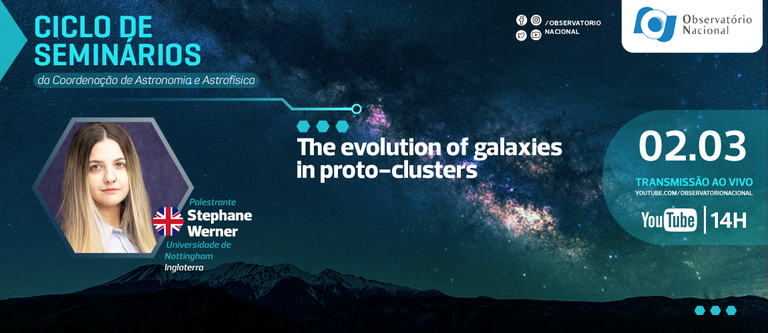Notícias
Seminário da Astronomia do ON aborda a evolução das galáxias em proto-aglomerados

Na quinta-feira, dia 02 de março, a Coordenação de Astronomia e Astrofísica (COAST) do Observatório Nacional – unidade de pesquisa vinculada ao Ministério da Ciência, Tecnologia e Inovações (ON/MCTI) – realizará a primeira edição de 2023 de seu seminário.
O evento acontecerá às 14h (horário de Brasília) e será realizado de forma híbrida, com transmissão ao vivo por meio do Canal do ON no YouTube e com palestra presencial no auditório Emmanuel Liais, no campus do ON, em São Cristóvão (RJ). O tema será a evolução das galáxias em proto-aglomerados.
Para falar sobre o assunto, foi convidada a pesquisadora Stephane Werner, da Universidade de Nottingham, na Inglaterra.
Title: The evolution of galaxies in proto-clusters
Abstract: The evolution of galaxies depends on the environment; however, little is known about how they evolved during the formation of galaxy proto-clusters at z>1.0. In the first part of this work, we quantify the relative importance of environmental quenching versus pre-processing in z∼1 clusters by analysing the infalling galaxy population in the outskirts of 15 galaxy clusters at 0.8<z<1.4 drawn from the GOGREEN and GCLASS surveys. We find significant differences between the infalling galaxies and a control sample; in particular, an excess of massive quiescent galaxies in the infalling region.
These massive infalling galaxies likely reside in larger dark matter haloes than similar-mass control galaxies because they have twice as many satellite galaxies. Furthermore, these satellite galaxies are distributed in an NFW profile with a larger scale radius compared to the satellites of the control galaxies. Based on these findings, we conclude that it may not be appropriate to use ‘field’ galaxies as a substitute for infalling pre-cluster galaxies when calculating the efficiency and mass dependency of environmental quenching in high redshift clusters.
By comparing the quiescent fraction of infalling galaxies at 1< r/R200<3 to the cluster sample (r/R200< 1) we find that almost all quiescent galaxies with masses >1011 M☉ were quenched prior to infall, whilst up to half of lower mass galaxies were environmentally quenched after passing the virial radius. This means most of the massive quiescent galaxies in z∼1 clusters were self-quenched or pre-processed prior to infall. We also extend our work to galaxy proto-clusters at z~2. Free-floating stars within galaxy clusters are thought to result from gravitational tides and galaxy interactions that rip stars away from their parent galaxies. Within the cosmological paradigm of hierarchical structure formation, such interactions accumulate over time which suggests that the amount of intracluster stars should be negligible in young proto-clusters and grow to around a quarter of the stellar mass in the oldest, most mature clusters. In contrast to these theoretical expectations, we report on the detection of copious intracluster stars within two proto-clusters at a redshift of 2. The distribution of stars in these protoclusters is similarly extended as in nearby mature clusters. This suggests that intracluster stars are a generic feature of massive dark matter halos, regardless of when these halos are observed.
Link para live no YouTube: https://www.youtube.com/watch?v=VvFylH38KwI
-
Durante este ano, os seminários da COAST estão acontecendo de forma presencial, híbrida ou remota – pelo canal do ON no YouTube. O horário do evento deverá ser sempre às 14:00 BRT.
Para mais informações: seminarioscoast@on.br
As edições anteriores estão disponíveis na PLAYLIST - Seminários e Colóquios 2022